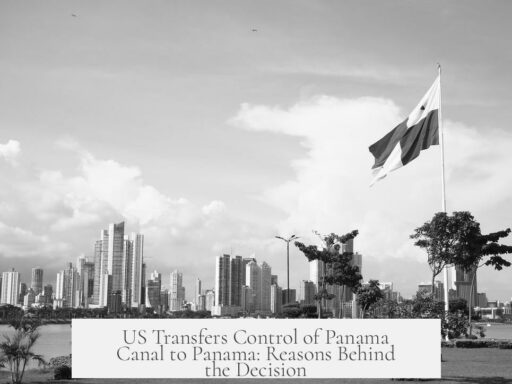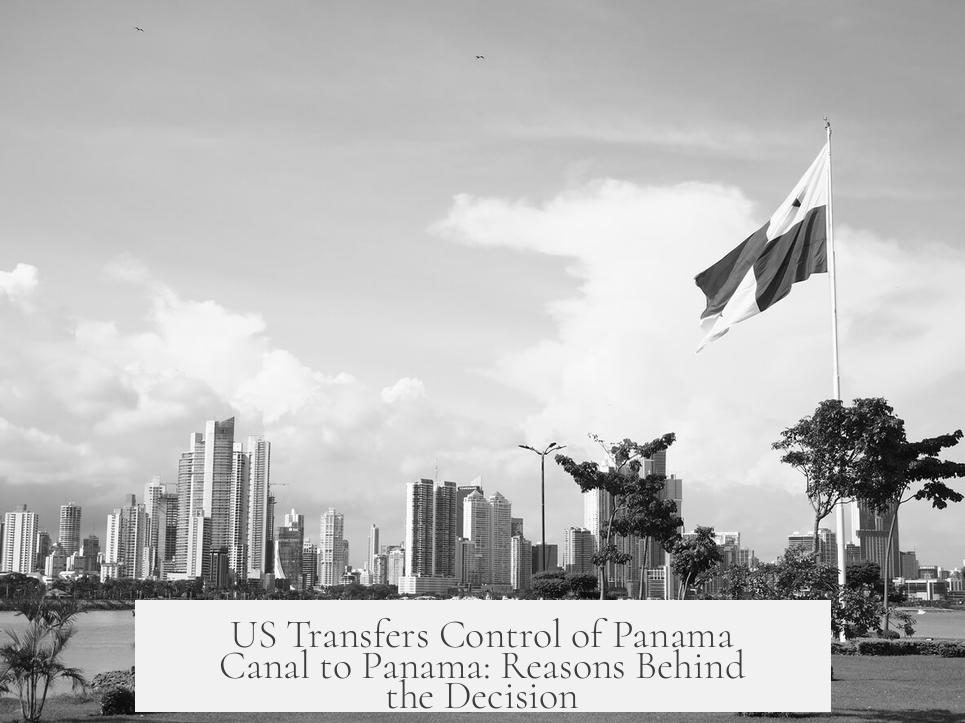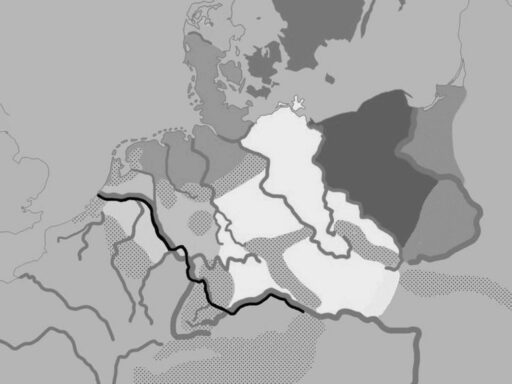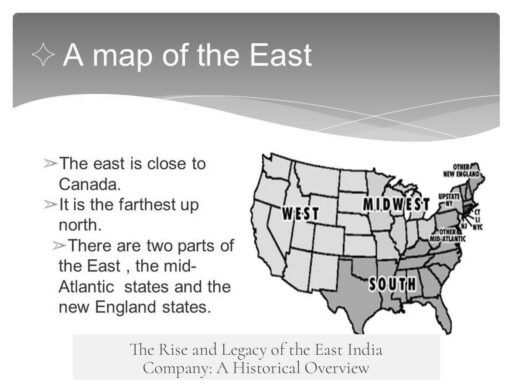The United States gave control of the Panama Canal to Panama to secure the canal’s efficient operation while addressing growing international and local opposition to American control.
Initially, the U.S. prioritized security and smooth functioning of the canal as its main interests in Panama. The canal was vital for global trade and military strategy. However, American control stirred tension, especially after January 9, 1964, when a violent clash between Panamanian protesters and U.S. Canal Zone guards resulted in 25 deaths. This incident caused significant international backlash and cast doubt on the legitimacy of U.S. sovereignty over the Panamanian territory housing the canal.
The American hold on the canal held colonial overtones, which damaged the U.S.’s diplomatic standing. Secretary of State Dean Rusk noted that no country today would willingly cede land with full sovereign rights to a foreign power as the original 1903 treaty allowed. This outdated arrangement became increasingly untenable amid shifting global norms on sovereignty and self-determination.
Moreover, tensions around American control risked threatening the canal’s security and operation, which was contrary to U.S. interests. The Suez Crisis, which destabilized another major shipping route, underscored the vulnerability of such key international passages and the need for a stable governance framework that respected the host country’s sovereignty.
To resolve these tensions, the U.S. entered negotiations that culminated in the Torrijos-Carter Treaties of 1977. These agreements transferred canal control to Panama but retained U.S. rights to defend the canal against threats to international trade. This balance addressed both Panamanian sovereignty demands and American strategic interests, helping to avoid further conflict and ensuring the canal’s continued safe operation.
- The U.S. initially controlled the Panama Canal to ensure security and operation.
- The 1964 riot exposed tensions and caused international backlash against U.S. control.
- American control was seen as colonial, harming diplomatic relations.
- The Suez Crisis highlighted the need for stable, sovereign control of strategic waterways.
- The 1977 Torrijos-Carter Treaties transferred control to Panama while protecting U.S. defense rights.
Why Did the US Give Control of the Panama Canal to the Panamanians?
The short answer: The United States gave control of the Panama Canal to Panama because it needed to maintain peace, respond to international pressure, and ensure the canal’s security and smooth operation in a changing world. Now, before you rush to assume it was just a generous handover, let’s dive deeper into the tangled blend of politics, pressures, and pragmatism that led to this historic shift.
For decades, the U.S. saw the Panama Canal as a jewel of strategic value. It shortened maritime routes, linking the Atlantic and Pacific Oceans, influencing global trade and military mobility. Its smooth operation and security were paramount. The canal wasn’t just a waterway; it was America’s shortcut to global power projection and commerce.
But with great power comes, well, great responsibility—and controversy. America’s involvement in Panama began with heavy colonial undertones. The original 1903 treaty gave the U.S. sweeping control and sovereignty over the Canal Zone, almost like drawing a red line on another country’s map and saying, “This is ours.” Not the best look diplomatically, especially as global attitudes toward colonialism evolved.
Here’s a crucial turning point: On January 9th, 1964, tensions boiled over. A scuffle between Panamanian protesters and American Canal Zone guards escalated into a riot. The aftermath? 25 deaths—21 Panamanians and 4 U.S. soldiers. The incident ignited fierce international criticism directed at the U.S. While America prized the canal’s security, such violent clashes highlighted the underlying resentment and sparked calls for change.
Imagine negotiating ownership of a major trade passage today and insisting on holding territory inside another sovereign nation, exercising full control like a colonial power. Pretty unrealistic, right? Even U.S. officials acknowledged this. Dean Rusk, the then-Secretary of State, admitted that if the treaty needed renegotiation in a modern context, no country would openly give up a piece of its land under such conditions. The world stage was shifting, and the 1903 treaty looked out of place.
There was also a larger geopolitical backdrop shaped by events like the Suez Crisis of 1956. The crisis revolved around Egypt’s control over the Suez Canal, leading to military confrontation and international tension. The U.S. saw how fragile control over critical waterways could be and worried similar uproar might threaten Panama. The lesson was clear: Heavy-handed colonial style control could provoke conflicts that would endanger American interests.
So how did America respond? Enter the Torrijos-Carter Treaties of 1977. These agreements symbolized a new diplomatic approach. The U.S. consented to transfer full control of the Panama Canal to Panama by the end of 1999. But here’s the clever part—America still reserved the right to defend the canal if any threat arose. It was a balanced move, weighing Panama’s growing national pride and global opinion against America’s pragmatic interests.
This treaty was more than a piece of paper; it was a recognition that cooperation and respect trumped old-fashioned control. It eased tensions with Panama and helped America shed those colonial vibes. Panama regained dignity, boasting ownership of one of the world’s most important pieces of infrastructure.
Was the handover risky for the U.S.? Maybe a bit. But it reflected smart restraint and adaptability. By ceding control, America avoided decades of further conflict, protests, and diplomatic headaches. The canal remained open and secure, continuing as a vital artery for international trade.
Today, the Panama Canal stands as a testament to cooperation and evolving diplomacy. It’s a reminder that control over strategic assets isn’t just about holding the reins tightly but managing relationships with wisdom and foresight.
What lessons can we learn here? Sometimes, the best way to protect your interests is to know when to let go. For the U.S., handing control back wasn’t weakness, but a savvy way to keep the canal safe, ensure smooth operations, and foster goodwill in a changing world.
Next time you read about the Panama Canal, think beyond the locks and ships. Think about how history, diplomacy, and practical strategy intertwined to shift control—and how that decision still shapes global trade today.
Why did the US decide to transfer control of the Panama Canal to Panama?
The US wanted to avoid conflicts and maintain good relations with Panama. After tensions rose in the 1960s, giving control helped ease political pressure and ensure the canal’s security and operation.
What event in 1964 influenced the US to reconsider its control over the Panama Canal?
A violent riot in 1964 killed 25 people, including Panamanians and US soldiers. This incident caused international criticism and highlighted the colonial nature of US control over the canal zone.
How did international opinion affect the decision to give Panama control of the canal?
Many countries saw US control as colonial. The US faced increasing diplomatic pressure to respect Panama’s sovereignty and avoid actions that seemed like foreign domination.
What role did the Torrijos-Carter Treaties play in the transfer of control?
Signed in 1977, these treaties formally handed over the canal to Panama. They also ensured the US could defend the canal against threats to international trade.
Why was US security still considered important after ceding control of the canal?
The canal’s safe and smooth operation was a top priority. The US retained rights to protect the canal to secure global trade routes, reflecting continued strategic interests.




